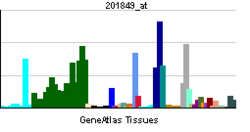BNIP3
BCL2/adenovirus E1B 19 kDa protein-interacting protein 3 is a protein that in humans is encoded by the BNIP3 gene.[1]
Function
This gene is a member of the BCL2/adenovirus E1B 19 kd-interacting protein (BNIP) family. It interacts with the E1B 19 kDa protein which is responsible for the protection of virally induced cell death, as well as E1B 19 kDa-like sequences of BCL2, also an apoptotic protector. This gene contains a BH3 domain and a transmembrane domain, which have been associated with pro-apoptotic function. The dimeric mitochondrial protein encoded by this gene is known to induce apoptosis, even in the presence of BCL2.[2]
Interactions
BNIP3 has been shown to interact with CD47,[3] BCL2-like 1[4] and Bcl-2.[1][4]
References
- 1 2 Boyd JM, Malstrom S, Subramanian T, Venkatesh LK, Schaeper U, Elangovan B, D'Sa-Eipper C, Chinnadurai G (Oct 1994). "Adenovirus E1B 19 kDa and Bcl-2 proteins interact with a common set of cellular proteins". Cell 79 (2): 341–51. doi:10.1016/0092-8674(94)90202-X. PMID 7954800.
- ↑ "Entrez Gene: BNIP3 BCL2/adenovirus E1B 19kDa interacting protein 3".
- ↑ Lamy L, Ticchioni M, Rouquette-Jazdanian AK, Samson M, Deckert M, Greenberg AH, Bernard A (Jun 2003). "CD47 and the 19 kDa interacting protein-3 (BNIP3) in T cell apoptosis". The Journal of Biological Chemistry 278 (26): 23915–21. doi:10.1074/jbc.M301869200. PMID 12690108.
- 1 2 Ray R, Chen G, Vande Velde C, Cizeau J, Park JH, Reed JC, Gietz RD, Greenberg AH (Jan 2000). "BNIP3 heterodimerizes with Bcl-2/Bcl-X(L) and induces cell death independent of a Bcl-2 homology 3 (BH3) domain at both mitochondrial and nonmitochondrial sites". The Journal of Biological Chemistry 275 (2): 1439–48. doi:10.1074/jbc.275.2.1439. PMID 10625696.
Further reading
- Kataoka N, Ohno M, Moda I, Shimura Y (Sep 1995). "Identification of the factors that interact with NCBP, an 80 kDa nuclear cap binding protein". Nucleic Acids Research 23 (18): 3638–41. doi:10.1093/nar/23.18.3638. PMC 307259. PMID 7478990.
- Maruyama K, Sugano S (Jan 1994). "Oligo-capping: a simple method to replace the cap structure of eukaryotic mRNAs with oligoribonucleotides". Gene 138 (1-2): 171–4. doi:10.1016/0378-1119(94)90802-8. PMID 8125298.
- Suzuki Y, Yoshitomo-Nakagawa K, Maruyama K, Suyama A, Sugano S (Oct 1997). "Construction and characterization of a full length-enriched and a 5'-end-enriched cDNA library". Gene 200 (1-2): 149–56. doi:10.1016/S0378-1119(97)00411-3. PMID 9373149.
- Chen G, Ray R, Dubik D, Shi L, Cizeau J, Bleackley RC, Saxena S, Gietz RD, Greenberg AH (Dec 1997). "The E1B 19K/Bcl-2-binding protein Nip3 is a dimeric mitochondrial protein that activates apoptosis". The Journal of Experimental Medicine 186 (12): 1975–83. doi:10.1084/jem.186.12.1975. PMC 2199165. PMID 9396766.
- Yasuda M, Theodorakis P, Subramanian T, Chinnadurai G (May 1998). "Adenovirus E1B-19K/BCL-2 interacting protein BNIP3 contains a BH3 domain and a mitochondrial targeting sequence". The Journal of Biological Chemistry 273 (20): 12415–21. doi:10.1074/jbc.273.20.12415. PMID 9575197.
- Chen G, Cizeau J, Vande Velde C, Park JH, Bozek G, Bolton J, Shi L, Dubik D, Greenberg A (Jan 1999). "Nix and Nip3 form a subfamily of pro-apoptotic mitochondrial proteins". The Journal of Biological Chemistry 274 (1): 7–10. doi:10.1074/jbc.274.1.7. PMID 9867803.
- Yasuda M, Han JW, Dionne CA, Boyd JM, Chinnadurai G (Feb 1999). "BNIP3alpha: a human homolog of mitochondrial proapoptotic protein BNIP3". Cancer Research 59 (3): 533–7. PMID 9973195.
- Ohi N, Tokunaga A, Tsunoda H, Nakano K, Haraguchi K, Oda K, Motoyama N, Nakajima T (Apr 1999). "A novel adenovirus E1B19K-binding protein B5 inhibits apoptosis induced by Nip3 by forming a heterodimer through the C-terminal hydrophobic region". Cell Death and Differentiation 6 (4): 314–25. doi:10.1038/sj.cdd.4400493. PMID 10381623.
- Ray R, Chen G, Vande Velde C, Cizeau J, Park JH, Reed JC, Gietz RD, Greenberg AH (Jan 2000). "BNIP3 heterodimerizes with Bcl-2/Bcl-X(L) and induces cell death independent of a Bcl-2 homology 3 (BH3) domain at both mitochondrial and nonmitochondrial sites". The Journal of Biological Chemistry 275 (2): 1439–48. doi:10.1074/jbc.275.2.1439. PMID 10625696.
- Vande Velde C, Cizeau J, Dubik D, Alimonti J, Brown T, Israels S, Hakem R, Greenberg AH (Aug 2000). "BNIP3 and genetic control of necrosis-like cell death through the mitochondrial permeability transition pore". Molecular and Cellular Biology 20 (15): 5454–68. doi:10.1128/MCB.20.15.5454-5468.2000. PMC 85997. PMID 10891486.
- Lee SM, Li ML, Tse YC, Leung SC, Lee MM, Tsui SK, Fung KP, Lee CY, Waye MM (Sep 2002). "Paeoniae Radix, a Chinese herbal extract, inhibit hepatoma cells growth by inducing apoptosis in a p53 independent pathway". Life Sciences 71 (19): 2267–77. doi:10.1016/S0024-3205(02)01962-8. PMID 12215374.
- Lamy L, Ticchioni M, Rouquette-Jazdanian AK, Samson M, Deckert M, Greenberg AH, Bernard A (Jun 2003). "CD47 and the 19 kDa interacting protein-3 (BNIP3) in T cell apoptosis". The Journal of Biological Chemistry 278 (26): 23915–21. doi:10.1074/jbc.M301869200. PMID 12690108.
- Kothari S, Cizeau J, McMillan-Ward E, Israels SJ, Bailes M, Ens K, Kirshenbaum LA, Gibson SB (Jul 2003). "BNIP3 plays a role in hypoxic cell death in human epithelial cells that is inhibited by growth factors EGF and IGF". Oncogene 22 (30): 4734–44. doi:10.1038/sj.onc.1206666. PMID 12879018.
- Okami J, Simeone DM, Logsdon CD (Aug 2004). "Silencing of the hypoxia-inducible cell death protein BNIP3 in pancreatic cancer". Cancer Research 64 (15): 5338–46. doi:10.1158/0008-5472.CAN-04-0089. PMID 15289340.
- Giatromanolaki A, Koukourakis MI, Sowter HM, Sivridis E, Gibson S, Gatter KC, Harris AL (Aug 2004). "BNIP3 expression is linked with hypoxia-regulated protein expression and with poor prognosis in non-small cell lung cancer". Clinical Cancer Research 10 (16): 5566–71. doi:10.1158/1078-0432.CCR-04-0076. PMID 15328198.
- Shen XY, Zacal N, Singh G, Rainbow AJ (2005). "Alterations in mitochondrial and apoptosis-regulating gene expression in photodynamic therapy-resistant variants of HT29 colon carcinoma cells". Photochemistry and Photobiology 81 (2): 306–13. doi:10.1562/2004-07-22-RA-242. PMID 15560738.
| |||||||||
This article is issued from Wikipedia - version of the Monday, October 26, 2015. The text is available under the Creative Commons Attribution/Share Alike but additional terms may apply for the media files.



